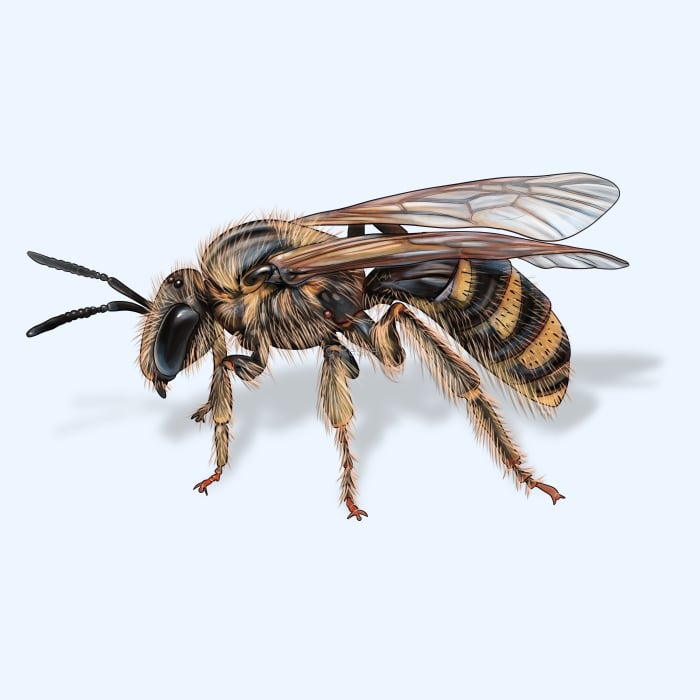How to identify and get rid of sweat bees

Don’t let sweat bees see you sweat!
When you’re out working in your yard or garden, glistening with sweat on a hot summer day, the last thing you want is a stinging insect bothering you. Sweat bees are notorious for seeking out sweaty bodies and slurping up your salty perspiration.
Sweat bees are shiny bees that are often seen around gardens and nearby outdoor activities during the late spring and early summer. Their main attention is pollination, where they look for pollen and nectar.
They do this to feed the larvae in their underground nests. They combine the nectar and pollen into balls that the larvae then feed on. Some species have a similar structure as honey bees, where the sisters help tend to the other larvae, and a queen bee does all the egg-laying.
Sweat bees aren’t aggressive by nature, but their curiosity can cause them to hover around people, landing on their skin to collect salt. When you go to brush them off or swat them, they often get in a sting as you squish them against your skin. This can lead to a mild burning sensation.
While sweat bees can be irritating for anyone trying to enjoy the outdoors, they are an important part of our ecosystem.
How to identify sweat bees
Sweat bees are small and can be identified by their often metallic coloring and attraction to sweat. They have clear wings with dark veins running through them. Most species have fine hairs that aid in pollination.
They're usually seen flying close to the ground or around flowers and are particularly drawn to humans during outdoor activities. If you're noticing these bees frequently around your home or garden, especially in areas where people gather or work up a sweat, it's likely you have a nearby nest.
These bees are solitary or have small colonies, so seeing large numbers isn't common, but their persistent presence can be a sign of multiple nests.
How big are sweat bees?
Sweat bees are on the smaller side, with most species measuring between 1/4 and 1/2 inch long.
Where do sweat bees live?
They can be found throughout the United States and on every continent except Antarctica. In the yard, sweat bees are commonly found near gardens or lawns, particularly around flowering plants. They nest in the ground or in wood, so look for them in bare or sandy soil and old wood structures.
How to get rid of with sweat bees
Sweat bees can be frustrating when you are exercising outside, working in your yard, or just hanging out outdoors. Here are a few steps you can take to minimize your exposure to sweat bees:
- Cover up: If you are working outdoors, consider wearing long sleeves and pants, as well as a hat.
- Cool down: Take breaks inside or in the shade if you are an excessive sweater.
- Don’t be so attractive: Rinse off sweat after outdoor activities and use unscented body products.
- Maintain your yard: Keep your lawn and garden well-maintained to reduce nesting sites.
Additionally, you can create and maintain a bug barrier around your home to prevent sweat bees from setting up their nests. Pestie offers DIY professional-grade pest control plans that are easy to use and highly effective at keeping sweat bees and other pests at bay.
Treat sweat bees with Pestie
If you're still having trouble keeping sweat bees away, the best option is to use a pro-grade, effective pest control solution like Pestie.
Pestie is a do-it-yourself pest control solution that's specially designed to keep sweat bees and other pests away from your home.
With Pestie, you can rest easy knowing that your living space is protected and free of creepy crawlies. And the best part? It's designed for people, pets, and the planet, so you can say goodbye to harsh chemicals and hello to peace of mind!
- Save hundreds compared to traditional annual pest plans
- People, pet, and planet-friendly
- Pro-grade customized formulas
Quick facts
How dangerous are Sweat Bees?
Medium danger risk
Sweat bees aren’t harmful to humans and are generally non-aggressive. They are more of a nuisance if and when they sting. Their sting is pretty mild compared to other bees and wasps.
- Scientific name
Family - Halictidae
- Colors
Metallic green, blue, red, yellow, black
- Life span
1 year
- Diet
Pollen and nectar
There are some species of sweat bees that are a bunch of cheaters. After another female from a different species makes a pollen ball and lays an egg on it, another female from a different species will come into the cell, eat the egg on the ball, and then lay her egg in replace of the original!








